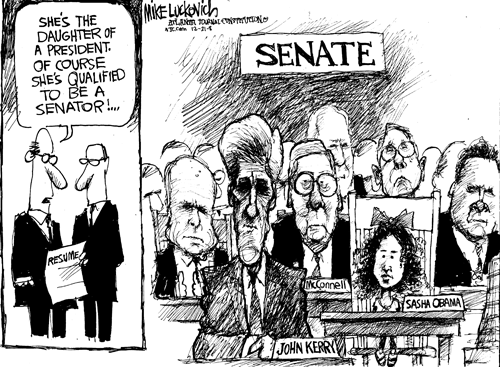"The End of America," an unsettling documentary polemic about the erosion of civil liberties in the wake of 9/11, brings up matters many of us would rather not contemplate in the middle of a financial crisis and on the eve of a new administration. Federal laws enacted during the last seven years that threaten our constitutional rights, it reminds us, remain in effect.
The pointedly inflammatory film, adapted from Naomi Wolf's book "The End of America: A Letter of Warning to a Young Patriot," compares the Bush administration's attempts to discourage dissent and to wield increasingly unchecked power to the events preceding the establishment of 20th-century dictatorships in Germany, Italy, Chile and elsewhere. Without explicitly invoking the word, it implies that since 2001 the United States has drifted toward fascism in the name of fighting terror.
Tightly constructed and fiercely one-sided, "The End of America," directed by Annie Sundberg and Ricki Stern ("The Devil Came on Horseback"), interweaves excerpts from a lecture in New York given by Ms. Wolf with film clips and interviews illustrating her contention that the rise of those dictatorships created a "blueprint" that the Bush administration, consciously or not, has followed.
According to Ms. Wolf, the first and fundamental tool for acquiring power is the manipulation of fear. In the shell-shocked post-
9/11 climate, the overwhelming public reaction to the Patriot Act of 2001, which gave law enforcement agencies expanded powers of surveillance, was mute acceptance of whatever was deemed necessary to keep us safe. Since then, she says, a color-coded system of terror alerts has been effectively wielded to keep us on edge.
From here, Ms. Wolf describes a 10-step program toward authoritarian rule that includes the creation of secret prisons where torture takes place; the deployment of a paramilitary force (Blackwater, which the film calls a contemporary American variation on Mussolini's private army of "black shirts"); the development of an internal surveillance system; the harassment of citizens' groups; and the arbitrary detention and release of ordinary civilians.
The film's most disturbing moments are its accounts of James Yee, a United States Armychaplain at Guantánamo, who was accused of espionage and held in solitary confinement for 76 days before being released, and Maher Arar, a Syrian-born Canadian telecommunications engineer, who was detained at Kennedy International Airport, then later deported to Syria, where he was imprisoned for a year and tortured. He was eventually cleared of charges of terrorism.
The seventh step, selecting key individuals for harassment, cites the Dixie Chicks and Dan Rather as prominent cases. The eighth step, the restriction of the press, focuses on the case of Josh Wolf, a journalist jailed for 226 days for refusing to turn over videotapes he made of police brutality at a July 2005 demonstration in San Francisco.
The ninth step, the equating of political dissidents with traitors, fleetingly examines the Bush administration's floating of the word "treason" to describe The New York Times's publication of classified information about the government's monitoring of overseas telephone calls. All these middle steps might be described as examples of selective intimidation intended to inhibit dissent. The case histories are glossed over.
The final step in Ms. Wolf's Top 10 is the suspension of the rule of law. She cites the refusal of Bush administration insiders subpoenaed to appear before Congress to testify in the United States attorneys scandal. The film ends on a note of stern warning: the 11th step might be the imposing of martial law.
If the film's vision of the steps leading toward a homegrown fascist state qualifies as paranoid, there is still enough here to make you shiver. Could it happen here? Maybe. A little fear — not the collective panic that followed 9/11 — can be a useful thing.

